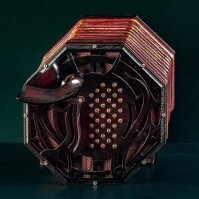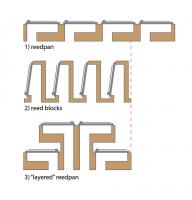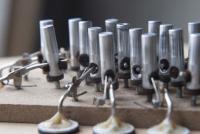-
Posts
656 -
Joined
-
Last visited
Posts posted by Łukasz Martynowicz
-
-
I know of Bastari square concertina - and yes, it is has a range that would satisfy my needs and - for a brief moment of hope - was my desired upgrade, but isn't it an unnobtainable instrument nowadays? There are only photos of a single one of them on the web. How many of them were ever produced?
Unfortunately, even if one would be available, there is a problem of cost of such instrument - building my own from scrapped reeds might not be a good way to obtain a perfect, concert class instrument, but it cuts down cost, leaving me only with a cost of material and time needed for designing and building an instrument (as I already have a workshop equipped quite well for the task).
As for "Hohner preciosa" and Ukebert - thank you for that. I've read what he has writen on his website and it looks that it's worth to give it a shot... At least to build a test setup for a couple of notes and test how it performs.
[i've edited my previous post a little: by darker/lighter range on the diagram I mean the colored section. The black&white hexes are just part of a grid on which I've worked on my desired layout and studied which buttons are needed to play in every key with uniform figering]
-
After reading through this forum for some time now, I think I have a pretty good idea of who you are, and I must admit, that getting support and a helping hand from the inventor himself is very encouraging. Thank you.
I have listed my main questions above, but maybe I'll add some detail to one of them, as it is the most fundamental. Because of overall number of keys and number of bass notes I'm aiming for, this would be a very large instrument if done using hybrid reedpan-accordion reeds method - probably in chemnitzer size range... On the other hand, using reed blocks will keep the size managable but it will make it sound more like accordion and increase the time and effort needed for woodworking all blocks. So, I came up with an idea of making something I called "layered reedpan" (attached is the schematic drawing of the idea).My question is - has anyone tried it before or have an idea of how the elongated air and sound travel will affect both the sound and response of reeds? From what I figured out so far, depending on the finish of the surface it will cut some of the higher harmonics, but I'm totally guessing on all the subjects regarding air pressure buildup and reed response (as in determining proper reed chamber sizes for example). Are there any resources on this matter which I can study?For further clarity of what I have in mind on this project, I'm attaching note/button range maps.The main section (darker) is "a must", accidentals in lighter color will be put in the instrument only if I somehow manage to do button linking, as I have only two sets of reeds and I don't want to increase size/weight further to fit doubled buttons with their own reeds. -
This will be a rather long post, but I hope it won't scare any of you off:)
I'm asking this questions hoping that one of you, concertina builders, could give me some general advices and directions on making my own instrument... I don't expect you to share "secrets of the trade" with me - I'm hoping for general "been there, done that, it does/doesn't work" answers and some general knowlege. I've read what I could find on this forum (and on Bob Tedrow site) on concertina building, but I'm still wondering on a few things..
The basic goal of this project is to build a Hayden duet with a range of a typical button accordion, as my desired repertoire consist mostly of conterporary accordion, klezmer, balkan and rock music. I now own an Elise, which being a great entry-level instrument has reached its limits and purchasing larger instrument is not an option because of two main reasons: first - range of available instruments (even Wakker H-2, Tedrow layout, and discussed elswere on this forum hypothetical Morse maximum layout do not fit my needs). And second - prices which, as reasonable as they are, are sadly far from reach for central european wages...
I have a quite large set of DIY skills, including metal machining (from stop-motion animation armature making) and both large and small scale woodworking.
As for the project itself - as I see it, it will be a hybrid instrument, with reeds scrapped from russian button accordion. I plan on building reedpan and action board first (with a final quality) and put it into a mocked up, prototype but playable case and then build final instrument gradually around it. It will have a normal single reed per note, riveted action aluminum buttons (same as in the modification of the Elise I own) with brass levers, will probably be square (to be as small as possible) and with leather bellows (in its final form - for the protype phase I plan on modifying an accordion bellows).
Now, finally for specific questions:
a) I wish to obtain as mellow, concertina like, sound as possible with accordion reeds. I have made some experiments to understand how different materials and fretwork pattern/fretless design affect sound. As for other factors to consider in modifying sound, can any of you make a sorted list of them, in order from the most influential to the least? (Except for proper concertina reeds of course:))
 As far as I can see, the hybrid reed chambers of modern concertinas are mostly the size of a reed shoe and "cubical" in shape. But accordion reed blocks are trapezoid in shape and often have inserts in them to further change the volume and shape of the reed chamber. Can someone explain to me how these differences affect sound and reed response (in general - again, I don't expect you to give me equations, rather answers what makes reeds slower/faster to speak and sound more mellow/bright)
As far as I can see, the hybrid reed chambers of modern concertinas are mostly the size of a reed shoe and "cubical" in shape. But accordion reed blocks are trapezoid in shape and often have inserts in them to further change the volume and shape of the reed chamber. Can someone explain to me how these differences affect sound and reed response (in general - again, I don't expect you to give me equations, rather answers what makes reeds slower/faster to speak and sound more mellow/bright)c) I know that using reedpan or reedblocks affect the sound considerably. Is it because of the airflow direction (straight vs "cornered") or sound reflection inside of the a reed chamber? As far as I know, reed instruments don't base on resonant qualities of wood - does a single reedpan affect the sound on any other basis than airflow direction/number of sound bounces in reed chamber (e.g thickness and mass of woodblock etc)?
c') As I can see on the only available picture, accordeaphone had a mix of reedpan and an accordion style reedblocks. Have any of you tried "layering" reedpans? It's a little hard to explain what I mean, but what I have in mind would allow overlaying reeds by as much as half of the lenght of the reed shoe and fit reeds in smaller box at a cost of thicker concertina ends (same as when using accordion-style reedblocks). Would such layered reedpan retain the concertina characteristic of sound? ( for some reeds air would have to travel twice as far between reed and valve/lever)
d) Does method of mounting reeds to the reed pan affect sound? I'm asking whether wax, wedge mount or L-screw have different stiffnes thus afecting sound in any significant way?
If you could spare a moment and answer some of those questions I would be thankfull.
PS.: please forgive me any mistakes, english is not my native language...
-
Łukasz, great post and pic!
Do you have any close-up photos or write-up as to how you did your bushings and new buttons? Do you have a lot of background in machining aluminum, or was making the buttons less difficult than it sounds? I'm not sure there's any chance that making aluminum buttons would be within my skill/tool level, but maybe if it's something easy for someone more skilled I can do a skills exchange with some acquaintance to knock out a batch of buttons for me.
Your English is great, so no worries there. Looking forward to hearing more about your project and music!
EDIT: if I go looking for buttons, does anyone know if the buttons are all the same across all the basic CC models? If I'm looking to convince a friend to make some aluminum ones, it may be an easier pitch if it's something that he could template out for larger production, and then maybe get more sales for if there are other folks wanting to do some DIY hot-rodding of the basic CC boxes.
This is how they look "under the hood" after a full year of intense use.
As of my background in machining, I would say I have enough
 I'm no professional, more like advanced hobbyist, but I do have a milling machine with
I'm no professional, more like advanced hobbyist, but I do have a milling machine with Compound Table and a decent machine vise. But I have done similiar projects using a multitool, drill press and file only.
The biggest problem with "DIY hot-rodding" set are the holes in the box itself. If you want them to be bushed you have to drill them 1.5-2 mm larger to make room for the felt. And they have to be on the exactly same axis, so you have to have a robust drill press or a milling machine and means to mount the side panel to it. Otherwise the holes will end up all over the place and you'll render your instrument useless..
Apart from that, making new keys is just copying the dimensions of original keys on pieces of aluminum rod and drilling two holes in each key - one for a lever and one for bottom post (this has to be made from stainless steel and glued into the hole).
As for 3d printed keys, I don't thing they will be smooth and strong enough and the bottom posts will have to be made from steel, so you will still have to drill some holes and cut some metal, so why bother, when you can have aluminum, brass or delrin buttons?
-
This is my first post on this forum, so greetings to everyone!
I don't have any experience with high-end or vintage concertinas, but I play the Hayden layout for 1.5 year now, of which almost a year on the Elise (I started learning it on a self-made 64 button MIDI instrument based on W-H2 layout, and prior to that I've played a 20 button Anglo for a year), and I think I have a quite reasonable beginner experience to share:
As someone already stated before, Elise, as limited as it is, is still more versatile than 20 button Anglo, and in my humble opinion, than 30 button Anglo either, considered being specifically designed for melody+accompaniment play. Especially for my type of repertoire, consisting mostly of modern rock covers, polish street music of pre- World War II times and some usually accordion-played arrangements (like Dansbanan, Beirut and Yann Tiersen). Even with 34 keys it has enough room for transposing song accompaniments to match different voices (one or two tones). Of course it sometimes lacks fully chromatic layout, but for me it is the short range of bass side and small overlap that is most limitting.
On the manufacturing/durability side: there were and are no problems with reeds or tuning, bellows is still a bit stiff on the pull towards the end of the range but despite some wear it is still airtight. Straps stretch with time, so now I use them one hole tighter than in the beginning. My biggest complain is about keys: the original plastic ones are loose, domed ends made my figers hurt after half an hour of playing, and the buzz appearing on transitions between close notes was ruining any pleasure from having an analog instrument after months of playing only MIDI, so I decided to make new ones: made from machined alluminum (original keys are very light and I didn't wanted to change springs), fully felt-bushed (both end board holes and lever holes), gave the Elise much needed precision, feel and nice, quiet keyboard work. And improvement on the looks of entire instrument

Attached is a photo of the LH side, with accented A below middle C (on RH side, the A above middle C is accented). The leather belt around the side is a part of my neck strap.
To conclude: I think this is a fine learning instrument, with a new Peacock and Tedrow (quite) affordable wider-scale concertinas there is a room for an upgrade, at least to a fully chromatic instrument, and in my opinion, the Hayden layout is easier and more intuitive to learn not only than other duets, but even a piano keayboard. So I must join "a profound and heartfelt 'thank you.' " for Mr. Hayden for reinventing and reintroducing this great layout!
(Please excuse me any mistakes in this and further posts as english is not my native language.)







No hope for poor hayden-wannabe-players?
in General Concertina Discussion
Posted
If I may add something on the matter of cheap Haydens.
When you look on the accordion world, you can choose your instrument from an at least "three dimensional space" of availability: by the type of an accordion, by the number of melody/bass notes and by the quality of sound/worksmanship. So, e.g. you can get a cheap russian bayan that will have a huge range, will let you learn and practice all the music you want but won't have any registers and will be f.. ugly.
In the whole concertina world (and that is most true for Haydens), apart for a range of chinese instruments, you always get best possible quality and and (almost) steady $-per-button rate. So if you "run out of buttons" you can only buy an instrument from much higher price range... I can be wrong on this, but isn't it one of the main reasons, why concertinas aren't as popular as they could be? As probably everyone can see, there is quite a lot of concertina videos on youtube, much of these are made by amateurs on cheap chinese or old german anglos. I know, that the market for Haydens (and all concertinas) is limited, but this is a closed loop - you can try Hayden only with an Elise, which is a very limited instrument... I live in Poland, and concertina is one of the most exotic free-reed instruments here - but when talking to people who like the sound of it, the first thing they talk about is how better it is over an accordion with its size, weight and portability.
From my point of view, there is a huge price gap between Elise and next-in-line Stagi and the perfect solution would be a "full" 46 key instrument made to little more than Elise standards (I think of bushed keys, because I had to change those buzzing plastic originals...) with a price around $600-700 (calculated from Elise price tag on $/button basis), just to build up the market for professional models. But, said that, I'm not into bussiness and I don't know what is the overall demand for concertinas of any kind or price...